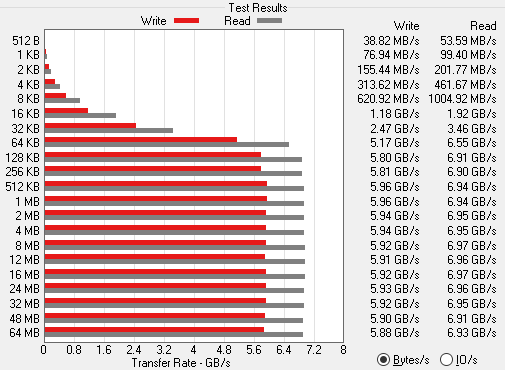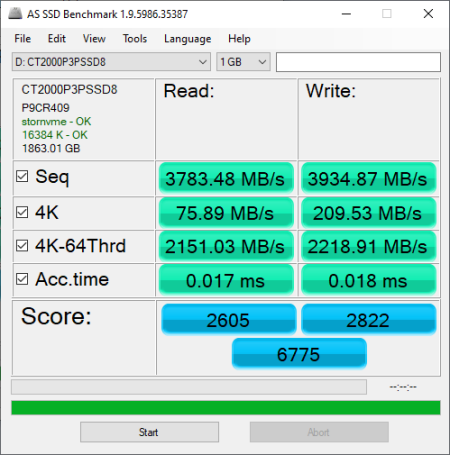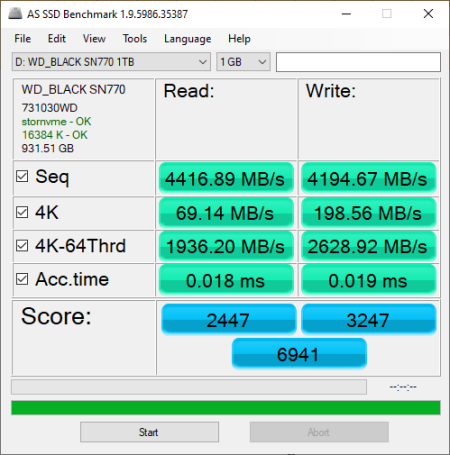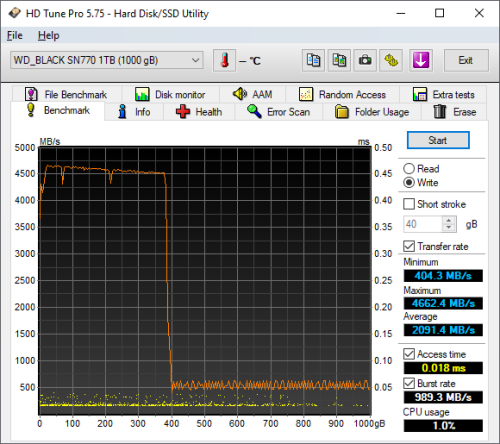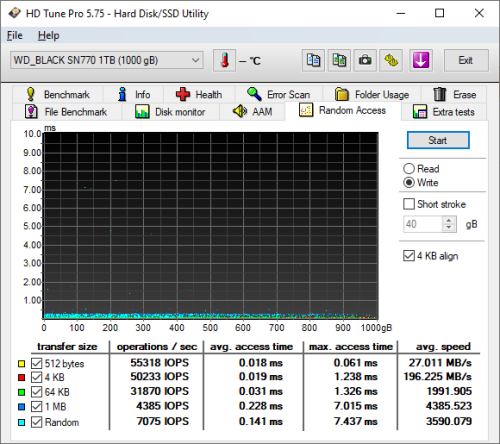

Model: Crucial P3 Plus 2TB PCIe 4.0 NVMe M.2 Solid State Drive
Manufacturer: Crucial
Provided By: Crucial
Crucial is a global brand of Micron Technology, Inc., one of the largest memory and flash storage manufacturers in the world. The company's product lineup includes award-winning solid state drives (SSDs) and computer memory upgrades (DRAM) for more than 50,000 systems. These products have been qualified and approved by major original equipment manufacturers and every single module has been rigorously tested at the component and module level. Each SSD also undergoes over a thousand hours of prerelease validation testing and hundreds of qualification tests to ensure optimal reliability and performance.
Earlier this year, Crucial added two new NVMe SSDs to its product lineup. In addition to the Gen3 P3, the company launched its latest Gen4 NVMe SSD, the P3 Plus. Designed to meet the needs of consumers, professionals, creators and gamers, this M.2 form factor drive is powered by Phison's PS5012-E21T controller and is available with up to 4TB of Micron's industry-leading 176-layer 3D QLC NAND flash. The P3 Plus also includes features like dynamic write acceleration, Redundant Array of Independent NAND (RAIN), multistep data integrity algorithms and adaptive thermal protection to keep your data safe while enhancing system reliability and performance. To top it all off, the drive is equipped with an ultra-fast PCIe Gen4 x4 NVMe 1.4 interface and is capable of 5,000 MB/s read and 4,200 MB/s write speeds.
The P3 Plus is available in 500GB, 1TB, 2TB and 4TB capacities. For this review, Crucial sent us the 2TB version of the drive which is capable of delivering up to 5,000 MB/s sequential read and 4,200 MB/s sequential write speeds as well as up to 680,000 random read and 800,000 random write IOPS.
| Crucial P3 Plus 2TB PCIe 4.0 NVMe M.2 Solid State Drive | |||||||||||||||||||||||||||
General Specifications
Performance
Reliability
Environmental
Other Features
|
Needless to say, this is only a taste of what the P3 Plus has to offer. To give you an idea of what to expect, we'll take a closer look at Crucial's new PCIe 4.0 SSD and then see how well it performs. Does the P3 Plus have what it takes? More importantly, is it the best bang for your buck? Keep reading as we find out.
The P3 Plus comes in a small, blue and white box. While there aren't a lot of technical details, the packaging includes a picture of the drive and advertises some of its key features including its 2TB capacity, support for PCIe 4.0 NVMe technology and 5 year warranty. The back of the box also has a small window that lets you see the drive and view the QR code on it. Inside, you'll find the P3 Plus as well as a mounting screw. To keep costs down, the drive does not come with a guide. However, if you need help, you can download the guide as well as the migration and cloning software from Crucial's website.
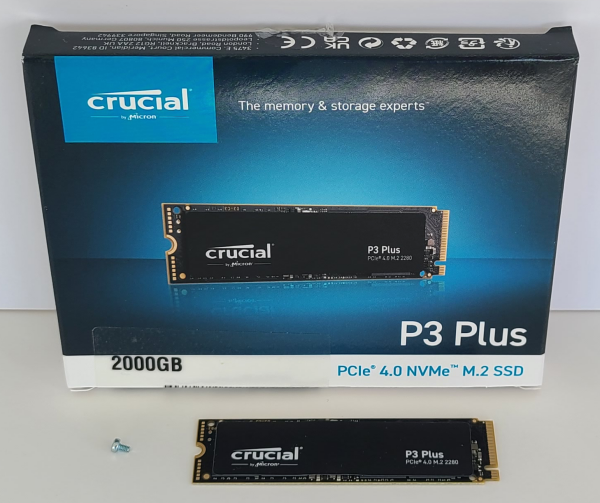
Physical Features:
The P3 Plus uses the 2280 form factor for M.2 (NGFF) SSDs. It measures 22 x 80 x 2.25 mm and tips the scales at less than 8g. The drive also has an "M key" edge connector which provides PCIe SSDs with up to 4x lanes of bandwidth.
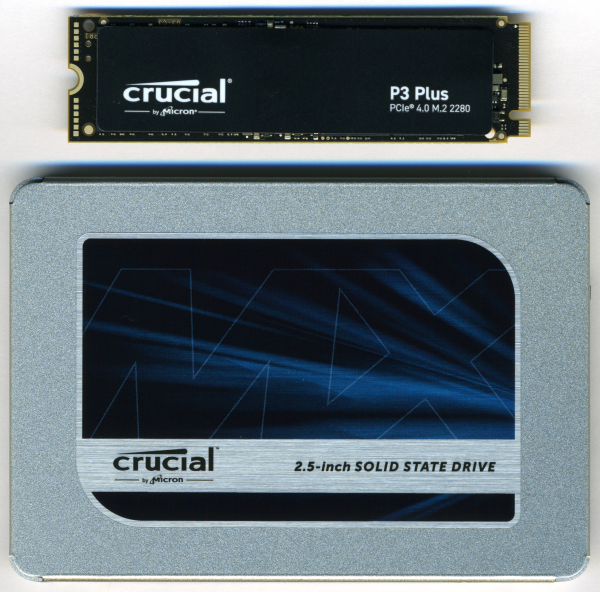
The P3 Plus uses Phison's PS5012-E21T controller chip. Manufactured in 12nm at TSMC, this DRAM-less, PCIe Gen 4 x4 NVMe 1.4 controller is equipped with a single ARM Cortex R5 core and has 4 NAND channels with 16 chip enables (CE) per channel. The E21T also offers support for 3D TLC/QLC NAND flash and features end-to-end data path protection, thermal throttling, Smart ECC 2.0 technology and Phison's fourth generation low-density parity-check (LDPC) ECC algorithm for improved drive reliability.


For the 2TB version of the P3 Plus, Crucial opted to use Micron's 176-layer (N48R) 3D QLC NAND flash. If you'd remove the sticker, you'd see that there are four 512GB NAND flash packages on the top of the PCB. There is also no DRAM cache chip as the PC Plus' controller takes full advantage of NVMe's Host Memory Buffer feature by using a small portion of the computer's memory to cache the mapping tables.
The test system used in this review is equipped with an AMD Ryzen 5 3700x CPU, MSI B550 GAMING PLUS motherboard, 16GB (8GB x 2) of Crucial Ballistix 3200 MHz DDR4 memory, Crucial P5 1TB SSD and a GIGABYTE GeForce GTX 1060 WINDFORCE OC 6G graphics card. For the operating system, I used the latest version of Windows 10 Pro.
To test the performance of Crucial's P3 Plus SSD, I ran a series of benchmarks using CrystalDiskMark, HD Tach RW, ATTO Disk Benchmark, AS SSD, HD Tune Pro, Anvil's Storage Utilities, Iometer and PCMark. For comparison, I've also included test results from the SK hynix Platinum P41, Silicon Power XS70, WD_BLACK SN770, ADATA XPG ATOM 50, ADATA XPG GAMMIX S70 Blade, Crucial P5 Plus, Plextor M10PY, ADATA XPG GAMMIX S70, Sabrent Rocket 4 Plus, WD_BLACK SN850, Silicon Power US70, ADATA XPG GAMMIX S50 Lite, ADATA Elite SE880, Kingston XS2000, ADATA XPG ATOM 30, Samsung 980, Silicon-Power UD70, Crucial P2, SK hynix Gold P31, Crucial P5, ADATA SWORDFISH, ADATA FALCON, Lexar NM610, Silicon Power P34A60, Patriot P300, Plextor M9PG Plus, Plextor M9PY Plus, Crucial X8, ADATA XPG SX6000 Pro, Western Digital WD_BLACK SN750, Samsung 970 EVO Plus, ADATA XPG SX8200 Pro, Crucial P1, ADATA XPG SX8200, Western Digital WD_BLACK NVMe, Samsung 970 EVO, Samsung 970 PRO, Plextor M9Pe, Plextor M8Se, Patriot Hellfire, ADATA XPG SX8000, Samsung 960 PRO, Toshiba OCZ RD400, Samsung 950 PRO, ADATA Ultimate SU670, Lexar NQ100, Samsung 870 EVO and Samsung 870 QVO.
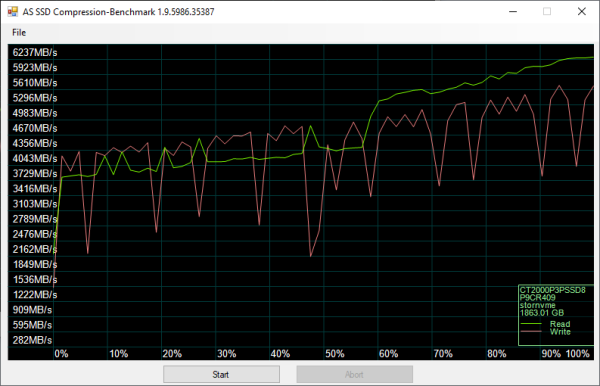
As I mentioned earlier, the P3 Plus uses Phison's PS5012-E21T controller chip. Looking at the screenshot above, you can see that there is a considerable performance difference when reading and writing incompressible (0%) and compressible (100%) data.
CrystalDiskMark 8.0.4:
First, I ran a few quick tests using CrystalDiskMark. This benchmark measures the performance of a storage device by testing its sequential and random read and write speeds. For this test, we're using the peak and real world profiles.
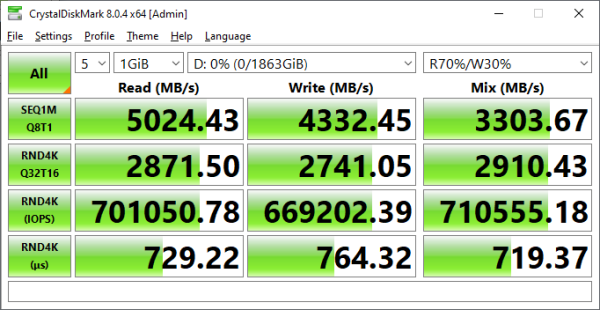
According to Crucial, the 2TB P3 Plus is capable of reading at 5,000 MB/s and writing at 4,200 MB/s. As you can see, the drive had no problems reaching these speeds in CrystalDiskMark's sequential read and write tests.
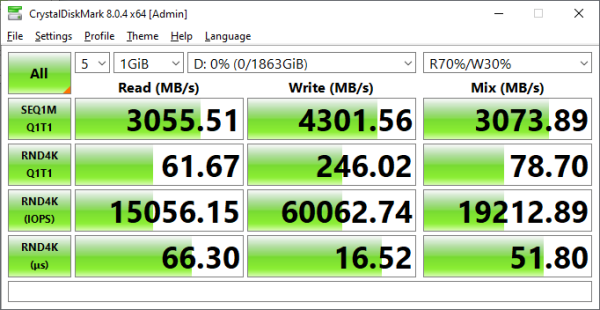
As you'd expect, the P3 Plus wasn't as fast when tested with the "real world" profile which uses a single thread and a much lower queue depth. Nevertheless, it was still able to read at 3,055 MB/s and write at more than 4,300 MB/s.
HD Tach RW 3.0.4.0:
Next, I used HD Tach to test the P3 Plus' read, write and burst speeds as well as its random access time and CPU usage.
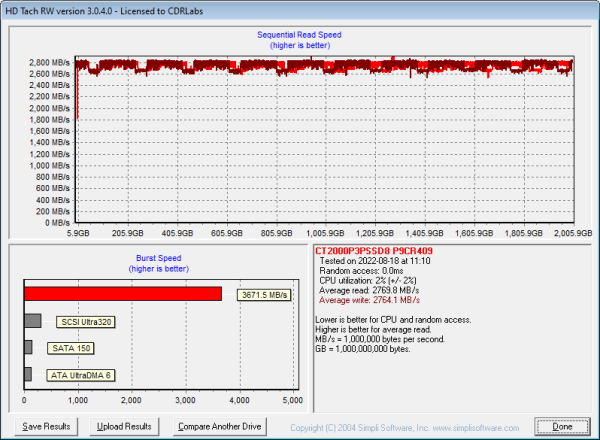
Looking at the screenshot above, you can see that the P3 Plus had average read and write speeds of 2769.8 MB/s and 2764.1 MB/s respectively, as well as a burst speed of 3671.5 MB/s.
ATTO Disk Benchmark 4.01:
I also used ATTO Disk Benchmark to test the P3 Plus' sequential read and write speeds. The tests are run using blocks ranging in size from 512B to 64 MB and the total length set to 256MB.
When tested with ATTO, the P3 Plus' read speeds topped out at about 6.97 GB/s and its write speeds at 5.96 GB/s.
AS SSD:
AS SSD is a benchmark designed specifically for solid state drives. The application contains five synthetic tests which are used to determine the sequential and random read and write performance of a drive.
AS SSD also includes a copy benchmark. This test copies an ISO (two large files), program (many small files) and game (small and large files), returning the speed and duration of each.
HD Tune Pro 5.75:
Next, I ran a series of tests using HD Tune Pro. This hard disk utility measures a drive's performance by testing its sequential read and write speeds as well as its access time, burst rate and CPU usage. For this review, I'm also going to use it to benchmark the WD_BLACK SN770's random read and write speeds, random access times and the number of operations per second.
The P3 Plus performed relatively well when benchmarked with HD Tune. The drive had average read and write speeds of 5702.2 MB/s and 5240.1 MB/s, respectively.
When reading 4KB blocks, the P3 Plus reached 58,861 IOPS and had an average speed of 229.928 MB/s. The drive was even faster when writing, reaching 61,781 IOPS with an average speed of 241.335 MB/s.
Anvil's Storage Utilities:
Anvil's Storage Utilities is another benchmark designed with SSDs in mind. The standard storage benchmark measures a drive's performance by testing its transfer speeds, access times and IOPS.

Iometer:
Lastly, I ran a series of tests using Iometer. This tool can be configured to benchmark a number of things. In this case, I used it to measure the P3 Plus' read and write speeds and the number of operations per second. The tests were run using random bytes and a queue depth of 3.

The P3 Plus' performance was very similar to what we saw in our other tests. The drive was able to read at 4757.58 MB/s and write at 4039.25 MB/s.

The P3 Plus also performed fairly well when doing random reads and writes. In our tests, the drive was able to read at 334.32 MB/s and write at 656.98 MB/s.

According to Crucial, the 2TB P3 Plus is capable of 680,000 IOPS when reading and 800,000 IOPS when writing 4K blocks. With two threads and a queue depth of three, the drive reached 85,587 random read IOPS and 168,188 random write IOPS.

The P3 Plus' random write performance was limited somewhat by its DRAM-less controller. With an 8GB test file, it peaked at about 231,000 IOPS. Using a smaller 1GB test file, the P3 Plus was able to bypass this limitation and reach a respectable 671,438 IOPS.
PCMark 8 - Storage Test:
PCMark 8 is a complete benchmark for Windows. It includes five benchmark tests, each designed around a specific scenario. The storage benchmark measures drive performance using real-world traces recorded from Adobe Creative Suite, Microsoft Office and a selection of popular games.

PCMark 8 also includes a consistency test which measures the performance consistency and degradation tendency of a storage system. The test reports the performance level at the start, the degraded steady-state and the recovered state as well as the number of iterations required to reach the degraded state and the recovered state. For this test, we are focusing on the Adobe Photoshop (Heavy) trace and will look at both the bandwidth and latency of the drive

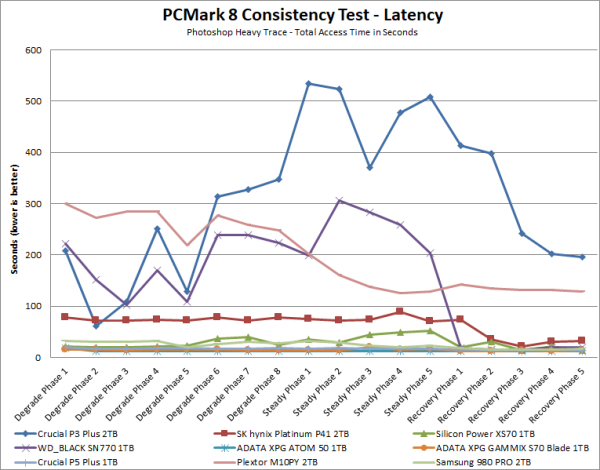
The P3 Plus didn't do as well as some of the other drives in this test. Its bandwidth dropped below 70 MB/s during the degradation and steady state phases, pushing its latency above the 500ms mark. The P3 Plus' performance increased somewhat during the recovery phase. However, it lagged well behind the drives from ADATA and Samsung, topping out at only 177 MB/s.
PCMark 10 - Full System Drive Benchmark:
PCMark 10's Full System Drive Benchmark uses a wide-ranging set of real-world traces from popular applications and common tasks to fully test the performance of the fastest modern drives. This benchmark produces an overall score as a measure of drive performance. Comparing devices is as simple as comparing scores. The tests also measure and report the bandwidth and average access time performance for the drive.
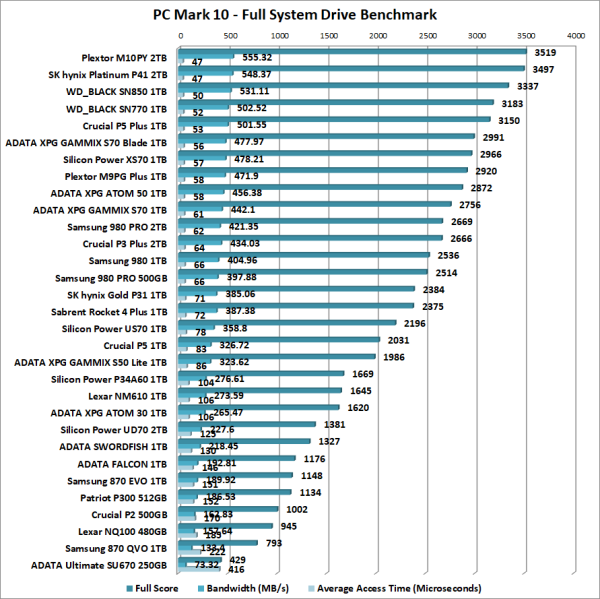
The P3 Plus performed surprisingly well for a DRAM-less drive equipped with QLC NAND. As you can see, it wasn't nearly as fast as the P5 Plus. However, it scored better than other PCIe 4.0 SSDs like the Samsung 980 and Sabrent Rocket 4 Plus.
TRIM Performance:
While SSD's offer many benefits, there are some downsides to using flash memory. One of the biggest issues people run into is performance degradation. Over time, an SSD will run out of fresh blocks and will have to write over data the file system has marked as deleted. This procedure is very complicated and can slow an SSD's write speeds considerably.
To fix this problem, most manufacturers have added TRIM support to their SSDs. The TRIM command allows an operating system, such as Windows 10, to tell an SSD which data blocks are no longer in use. Using this information, the drive pro-actively erases these blocks and adds them to the free block pool.
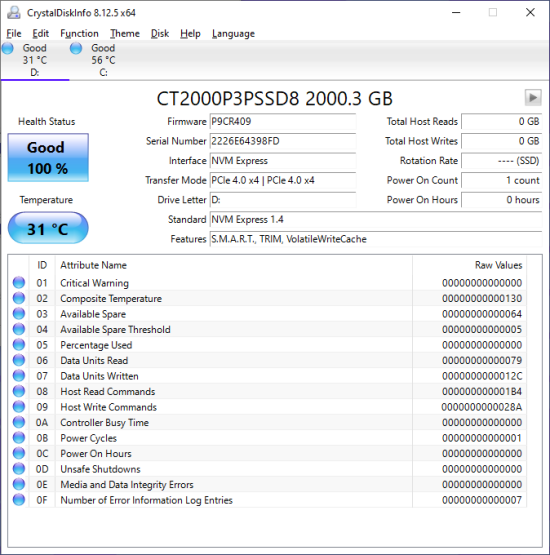
To test the P3 Plus's TRIM and garbage collection functions, I first put the drive in a "dirty" state. I used Iometer to fill 80% of the drive and then ran a random write test for 30 minutes. Looking at the screenshot below, you can see that the P3 Plus' average read and write speeds dropped to 2671.15 MB/s and 88.80 MB/s, respectively.
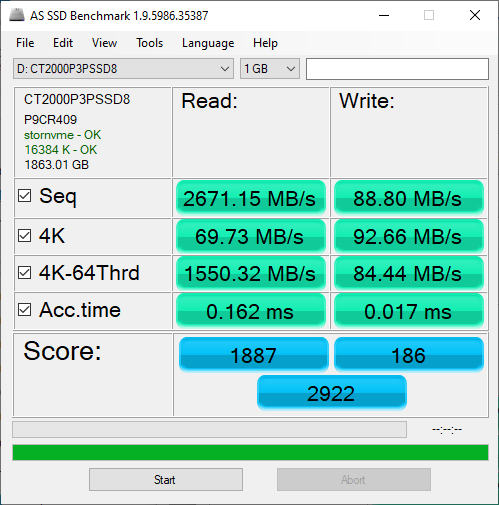
Crucial P3 Plus - Dirty
To see how well the P3 Plus could recover, I let the computer sit for about 30 minutes and then reran the test. The drive wasn't able to reach the factory fresh performance shown in our earlier tests. However, its sequential write speed jumped up to 3792.15 MB/s.
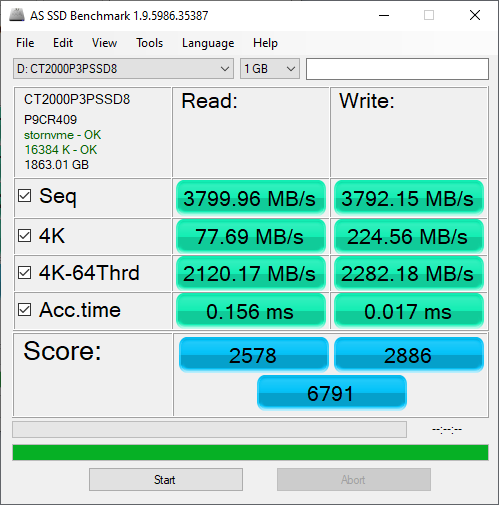
Crucial P3 Plus - After TRIM
Lastly, I used Parted Magic to perform a secure erase on the P3 Plus. With the drive wiped clean, it had average read and write speeds of 3787.53 MB/s and 3950.71 MB/s, respectively.
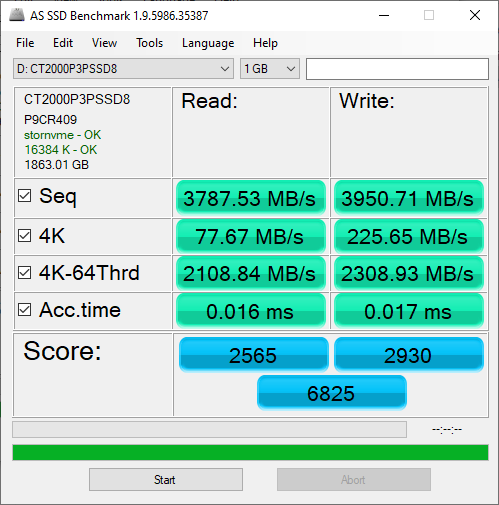
Crucial P3 Plus - Secure Erased
Final Thoughts:
The Crucial P3 Plus is a great choice for the consumer, professional or gamer looking for an affordable balance of capacity and PCIe 4.0 performance. This compact, M.2 form factor SSD is powered by Phison's DRAM-less PS5012-E21T controller and is available with up to 4TB of Micron's 176-layer 3D QLC NAND flash. Combine this with NVMe's Host Memory Buffer (HMB) feature and a PCIe Gen4 x4 interface and you have a drive capable of transferring data at speeds well beyond that of the fastest PCIe 3.0 SSDs. In our sequential read and write tests, the 2TB version of the P3 Plus was able to read at speeds as high as 5,024 MB/s and write at speeds in excess of 4,300 MB/s. It also did fairly well in our random write tests, producing more than 168,000 IOPS at low queue depths.
Despite being budget friendly, the P3 Plus includes many of the same features found on Crucial's higher-end SSDs. The drive uses technologies like Dynamic Write Acceleration to optimize performance as well as multistep data integrity algorithms and Redundant Array of Independent NAND (RAIN) to protect data and prevent it from becoming corrupted. The P3 Plus also features thermal and power loss protection, active garbage collection and device sleep support which extends the battery life of a device by reducing the drive's power consumption when it's not in use. To top it all off, it comes with Acronis True Image cloning software and is covered by a generous 5 year warranty.
The Crucial P3 Plus is available now in 500GB, 1TB, 2TB and 4TB capacities. Prices on Amazon.com currently range from $55 up to $290, with the 2TB version reviewed here retailing for about $156.

Highs:
- Available in 500GB, 1TB, 2TB and 4TB capacities
- PCIe 4.0 x4 interface with NVMe protocol
- Phison PS5012-E21T controller
- Equipped with Micron 176-layer 3D QLC NAND
- Very good sequential read and write performance
- Good random read and write performance in most situations
- Small M.2 2280 form factor
- Dynamic Write Acceleration
- Supports Redundant Array of Independent NAND and Multistep Data Integrity Algorithms
- Supports TRIM and active garbage collection
- Thermal and power loss protection
- Host Memory Buffer (HMB)
- Includes Acronis True Image cloning software
- Reasonably priced
- 5 year warranty
Lows:
- Does not support hardware based encryption


